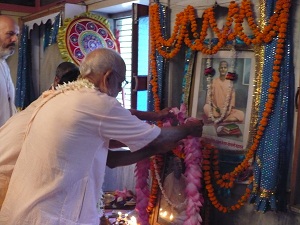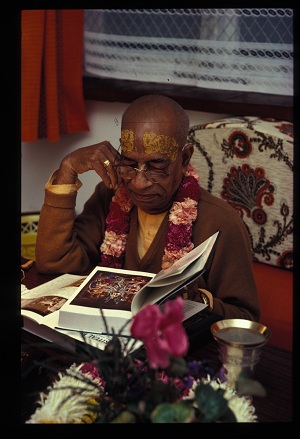Sri Srimad Bhaktivedanta Narayana Gosvami Maharaja
November 10, 1991
(first published August 2011)
Today is a very auspicious day.
When Sri Guru is on this planet, we have a relation with him as guru and disciple. At that time our entire energy goes into carrying out his order, and we are not solely able to think, outwardly and internally, about his deep motive for coming to this world. Today, on this auspicious day, we have the opportunity to think about his entire life: who he is, what he did, what he wanted to teach, and why he came to this sphere.
When Sri Caitanya Mahaprabhu and Sri Krsna were present, people could not understand Their mission. However, after They left the vision of this material world, Their internal mission became more clear.
Now, your Prabhupada, my siksa-guru, is not here within our vision, but he is here. He is everywhere. Although we do not have the eyes to see, he is everywhere. He is akanda-guru-tattva, a manifestation of Nityananda Prabhu, or Baladeva Prabhu.
 When Krsna was in Vrndavana, the gopis danced with Him in rasa-lila, and they were always absorbed in amorous pastimes with Him. Still, when He went to Mathura and then to Dvaraka, they realized something more than they had during their meeting with Him. They realized a special vipralamba-bhava (an internal meeting within feelings of separation).
When Krsna was in Vrndavana, the gopis danced with Him in rasa-lila, and they were always absorbed in amorous pastimes with Him. Still, when He went to Mathura and then to Dvaraka, they realized something more than they had during their meeting with Him. They realized a special vipralamba-bhava (an internal meeting within feelings of separation).
With our material vision, we mostly remember Srila Bhaktivedanta Svami Maharaja in that form which we have seen. He has told something, he has ordered some service, and he has given so many teachings. But now, after some days, he has left this sphere and has gone to his Lordships, Sri Sri Radha-Krsna.
By his disappearance, he has given an opportunity for us to know who he really is and for what purpose he came here. He wrote Bhagavad-gita As It Is, Easy Journey to Other Planets, a translation and commentary of Srimad-Bhagavatam, and so many other authentic literatures. He wanted to do something more, but he could not do so because you did not have sufficient qualification for him to give everything he wanted to give you. Now, by his grace, you are in a somewhat better mood to understand him.
When Krsna was in Dvaraka, he ordered Uddhava to come to Vrndavana. When Uddhava received that order, he said, "You are sending me to Vrndavana, but how can I live in Vrndavana without You?" Krsna replied, "Don't think like that. I am a billionth part in Mathura, but I am fully in Vrndavana with the gopis. When you go to Vrndavana, you will see that I am solely in Vrndavana with them, and that I am not at all in Mathura."
Similarly, today is the day we can think more and more about Svamiji, your Prabhupada – who he is and what he came to give in this world.
Numerous teachers and preachers went to Western countries, like the mayavadi teacher Vivekananda. Even now, so many preachers are going to the Western countries as well as to other parts of the world, but they cannot give what your Prabhupada has given. They take their own theory and give that in new bottles, but he has given what Sri Caitanya Mahaprabhu Himself came to give to this world. Mahaprabhu garlanded the world with the holy name and prema.
sei dvare acandale kirtana sancare
nama-prema-mala ganthi' paraila samsare
(Sri Caitanya-caritamrta, Adi-lila 4.40)
["Thus He spread kirtana even among the untouchables. He wove a wreath of the holy name and prema, with which He garlanded the entire material world."]
Caitanya Mahaprabhu's identity is explained in the following verse:
namo maha-vadanyaya krsna-prema-pradaya te
krsnaya krsna-caitanya-name gaura-tvise namah
(Sri Caitanya-caritamrta, Madhya-lila 19.53)
["I offer pranama unto Sri Krsna Caitanya, who is Sri Krsna himself. Having assumed the golden hue of Srimati Radhika, He is munificently bestowing krsna-prema, the rarest of all gifts."]
Caitanya Mahaprabhu is maha-vadanya, and similarly Srila Rupa and Sanatana Gosvamis are maha-vadanya. In our guru-parampara, Jiva Gosvami, Raghunatha dasa Gosvami, Krsnadasa Kaviraja Gosvami, Visvanatha Cakravarti Thakura, Baladeva Vidyabhusana, and Bhaktivinoda Thakura are all maha-vadanya, because they have tried to give the same thing that Sri Caitanya Mahaprabhu wanted to give. Srila Prabhupada Bhaktisiddhanta Sarasvati Thakura sent Srila Bhaktivedanta Svami Maharaja to the West, knowing that as a very great personality, Srila Svami Maharaja could fulfill his heart's desire in the Western countries.
Vivekananda could not give anything of value to the West. Similarly, all other preachers who went there could only give three things: dharma (material religion), artha (economic development), and kama (sense gratification). Some preachers tried to give moksa (impersonal liberation), but they did not try to give krsna-prema.
Srila Bhaktivedanta Swami Maharaja went to the West, alone. His guru was with him, and Radha, Krsna, Mahaprabhu, and Nityananda Prabhu were with him, but we could not see Them. We only saw that he was alone, and that he came with not a single paisa.
I first met him in Calcutta, on Aksaya-tritya, the day on which the Gaudiya Vedanta Samiti was established. My Gurudeva, Srila Bhakti Prajnana Kesava Gosvami Maharaja, who later gave him the sannyasa order, had called for him. Your Srila Prabhupada was a householder at that time. I had not seen him before, but I knew him by hearing about him – to see by ears is more valuable than seeing by eyes. I had heard so many times from my Gurudeva that he was a very great personality, an excellent writer and knower of sastra, a fearless preacher of truth – fearing no one. I had heard that he had written several articles in the Gaudiya Patrika and Hindi Bhagavata Patrika, and also for his Harmonist magazine. I also knew that his Srila Prabhupada had told him that he would have to go the Western countries to preach Sri Caitanya Mahaprabhu's teachings there.
When I first saw him, I was very much attracted to him, and after that I used to sit and talk with him. He was not giving many lectures at that time, but his speaking was very powerful and influential. For example, he explained this verse.
ete camsa-kalah pumsah
krsnas tu bhagavan svayam
indrari-vyakulam lokam
mrdayanti yuge yuge
(Srimad-Bhagavatam 1.3.28)
["All the lists of the incarnations of Godhead submitted herewith are either plenary expansions or parts of the plenary expansions of the Supreme Godhead, but Krsna is the Supreme Personality of Godhead Himself."]
Whenever he would give lectures from Srimad-Bhagavatam, and discuss verses such as this one, he used to give such beautiful word-for-word explanations that everyone present clearly understood the meanings; they were satisfied and they admired him.
So, I first saw him in Calcutta, and then in Allahabad, and I used to minutely read his many articles in Gaudiya Patrika.
He is a perfect self-realized soul, an eternal associate of Radha-Krsna, and, like Krsna, he performed human-like pastimes in this material world. He played the role of a sadhaka advancing in Krsna consciousness. In that role, when he came to Mathura he told me, "I was afraid to leave my connections with this world and take the sannyasa order. I read in Srimad-Bhagavatam that those who take shelter of Krsna become without possessions or wealth:
yasyaham anugrhnami
harisye tad-dhanam sanaih
tato 'dhanam tyajanty asya
svajana duhkha-duhkhitam
(Srimad-Bhagavatam 10.88.8)
["The Personality of Godhead said: If I especially favor someone, I gradually deprive him of his wealth. Then the relatives and friends of such a poverty-stricken man abandon him. In this way he suffers one distress after another."]
He told me, "I used to fear this verse, but by chanting and serving, I have decided that I am going to take sannyasa here in Mathura."
At first people did not know him; they did not know that he was so qualified. However, after his taking sannyasa and going to Jhansi, Agra, and other places, people learned something of his greatness.
I was with him when he moved from Mathura to the Radha-Damodara Temple, and I saw that he extreme renunciation. He had nothing with him other than an old, torn quilt. He had no proper blanket. I used to give him my chaddar, and on that we would sit together and converse about Srila Rupa Gosvami and the other Gosvamis. During that time he would also show me what he was writing. At midday we would make chappatis together – he would roll them I would cook them – and then we would honor prasada together.
I was also with him in Delhi, where he was always busy in writing and chanting. He never wasted a moment. I was with him in Mathura, where he was also absorbed in writing – and planning. He made a plan in Mathura to go to Western countries, and there he told me, "If necessary, I will make hostels; and if needed I will distribute eggs, meat, and wine. I have full faith that by their taking the holy name of Krsna, they will leave all this in a very few days." Soon he went there, and in no time at all he spread this mission throughout the entire world.
I have never seen an acarya like him. Even Sankaracarya took some time to preach his mission, and he spread it only in India. But Srila Bhaktivedanta Svami Maharaja spread his mission in the whole of India, in Western countries, Eastern countries, and everywhere else, in just 'a few days' – from 1965 to 1977. He established numerous centers of Sri Sri Radha-Krsna, Sri Caitanya Mahaprabhu, and Jagannatha Deities. He brought so many good boys, scholars like Tamal Krsna, Bhavananda, Brahmananda, Kirtanananda; many hundreds of thousands of boys and girls, women and children, and he made so many sannyasis and brahmacaris. Devotees in all other groups of Gaudiya Mathas admit the fact that his disciples have so much faith in their Gurudeva, and I also agree with this. They are very qualified.
He employed his magic wand and gave a shape to the foretelling of Bhaktivinoda Thakura, and we see now that Indians and Westerners all over the world are shaving their heads, dawning sikha, and mala – and that both lady and gentlemen devotees are chanting "Hare Krsna Hare Krsna Krsna Krsna Hare Hare, Hare Rama Hare Rama Rama Rama Hare Hare."
In India all our asramas are without ladies, but he has given a scope for Western persons. If I were to tell everyone in the West to be brahmacaris and sannyasis, it would be so hard to preach there. Moreover, every jiva – both male and female – has the quality and birth-right to serve Krsna. In Kali-yuga there is necessity to be very broadminded, and therefore he has given this scope. If he had not done so, this preaching of Mahaprabhu's mission would not have been so successful throughout the world.
He did not have much time, so his public preaching mostly consisted of general topics. He discussed so many profound teachings in his books. At the same time, considering his audience, he could not preach everything he wanted to preach.
There are many stages in bhakti, and in this world we can only go up to the stage of bhava:
adau sraddha tatah sadhu-sango' tha bhajana-kriya
tato 'nartha-nivrttih syat, tato nistha rucis tatah
athasaktis tato bhavas, tatah premabhyudancati
sadhakanam ayam premnah, pradurbhave bhavet kramah
(Bhakti-rasamrta-sindhu 1.4.15-16)
["In the beginning one must have a preliminary desire for self-realization. This will bring one to the stage of trying to associate with persons who are spiritually elevated. In the next stage one becomes initiated by an elevated spiritual master, and under his instruction the neophyte devotee begins the process of devotional service. By execution of devotional service under the guidance of the spiritual master, one becomes free from all material attachment, attains steadiness in self-realization, and acquires a taste for hearing about the Supreme Personality of Godhead, Sri Krsna. This taste leads one further forward to attachment for Krsna consciousness, which is matured in bhava, or the preliminary stage of transcendental love of God. Real love for God is called prema, the highest perfectional stage of life."]
Real bhakti is uttama-bhakti.
Your Srila Prabhupada wanted to preach all the same topics that I am sharing in Western countries – everything that Srila Rupa Gosvami gave in Bhakti-rasamrta-sindhu, Ujjvala-nilamani, and all his other books; what Srila Raghunatha dasa Gosvami, Srila Krsnadasa Gosvami, and also what was given by other prominent acaryas in guru-parampara. He wanted to expand on all these bhakti topics in Western countries, but he could not fully do so at that time. He had only twelve years.
He tried to give sraddha, then nistha, then ruci, and so on. We must know what is nistha. We are chanting harinama and we are engaged in the devotional activities of sravanam, kirtanam, visnu smaranam, pada-sevanam, arcanam, vandanam, dasyam, sakhyam, atma-nivedam. We are also engaged in:
sadhu-sanga, nama-kirtana, bhagavata-sravana
mathura-vasa, sri-murtira sraddhaya sevana
(Sri Caitanya-caritamrta, Madhya-lila 22.128)
["One should associate with devotees, chant the holy name of the Lord, hear Srimad-Bhagavatam, reside at Mathura, and worship the Deity with faith and veneration."]
We are engaged in these devotional practices, but we require to delve deeply into them. First, we need to know their meanings. What is the meaning of nistha? It is the stage wherein anarthas disappear. What are anarthas?
asat-sanga-tyaga,—ei vaisnava-acara
'stri-sangi'—eka asadhu, 'krsnabhakta' ara
(Sri Caitanya-caritamrta, Madhya-lila 22.87)
["A Vaisnava should always avoid the association of ordinary people. Common people are very much materially attached, especially to women. Vaiñëavas should also avoid the company of those who are not devotees of Lord Krsna."]
We should not associate with those who are absorbed in worldly sense gratification and intoxication, and those who do not perform bhakti to Krsna.
Svarupa-brahma, asat-trsna, hrdaya-durlabha, and aparadha – these are all anarthas. Regarding aparadas, there are four kinds: nama-aparadha, vaisnava-aparadha, dhama-aparadha, and seva aparadha.
Srila Visvanatha Cakravarti Thakura has written about this in Madhurya-kadambini, where he has also defined nistha: ["Nistha means to be endowed with the quality of steadiness. Though a person tries for steadiness every day, while the anarthas are still present, he will not attain steadiness. This is due to these five persistent obstacles: laya (sleep), vikshepa (distraction), apratipatti (indifference or disinterest in spiritual topics), kasaya (tendency toward bad habits) and rasasvada (taste for material enjoyment). After the stage of anarthas-nivritti, when these obstacles are almost completely destroyed, one achieves steadiness. Thus, the symptom of nishtha is the absence of the above-mentioned obstacles."]
A devotee situated in nistha is of the conviction that, "I can leave my body, but yet I cannot leave krsna-bhakti." This is nistha. At present we may sometimes desire to chant daily sixty-four rounds (one-hundred-thousand names) of harinama, as Sri Caitanya Mahaprabhu, the Gosvamis, and other pure devotees used to do, but when we go to Vimala-kunda and Radha-kunda we catch a cold, and therefore we decide that we cannot continue. Nistha is the absence of obstacles to our bhakti practices.
Then ruci, or taste, comes; and when asakti comes, we feel that we will die if we do not chant the holy name or hear hari-katha.
Sraddha (faith) is of two kinds; vaidhi and raganuga. Srila Bhaktivedanta Svami Maharaja spread vaidhi-bhakti. It was not appropriate at that time for him to teach raganuga-bhakti, as you were not qualified to accept it. He wrote about it in his books, and he showed the path of how by practicing vaidhi-bhakti you can enter raganuga-bhakti. Raganuga-bhakti comes from lobha-mayi sraddha, or sraddha imbued with genuine greed for it. If one has genuine greed in the pastimes of Srimad-Bhagavatam, in gopi-bhava, or in vatsalya-bhava or sakhya bhava, he will attain the perfectional stage of bhakti. Especially, Sri Caitanya Mahaprabhu came here to give sva-bhakti-sriyam.
anarpita-carim cirat karunayavatirnah kalau
samarpayitum unnnotjjvala-rasam sva bhakti sriyam
harih purata sundara-dyuti-kadamba sandipitah
sada hrdaya-kandare sphuratu vah saci-nandanah
(Sri Caitanya-caritamrta Adi-lila, 1.4)
["May that Lord, who is known as the son of Srimati Sacidevi, be transcendentally situated in the innermost chambers of your heart. Resplendent with the radiance of molten gold, He has appeared in the age of Kali by His causeless mercy to bestow what has not been given in a very long time – manjari-bhava, the service of Srimati Radhika as Her confidential maidservant."]
The meaning of this verse is profound. Srila Bhaktivedanta Svami Maharaja has come to give this same gift that Mahaprabhu came to give, but he had to first prepare the soil of the land in order to give the seed. He gave the seed, but he had to spend so much of his time making good soil. He taught that if in this world there is mayavada, bhakti cannot reside there. What was his aim and ambition? He has come only to give Sri Caitanya Mahaprabhu's mission as described in the above-mentioned verse.
What is the meaning of unnnotjjvala-rasa as mentioned in the verse? It is gopi-bhava (the paramour love of the Vraja gopis), not the svakiya-bhava (wedded love) of Dvaraka. Caitanya Mahaprabhu and Svamiji have not come to give this type of unnnotjjvala-rasa. Caitanya Mahaprabhu has come to taste these things, not to give to others. They have both come to give unnotjjvala-rasam sva-bhakti sriyam, Sva means Radhika, and the word bhakti in this verse refers to Radhika's prema.
sri-radhayah pranaya-mahima kidriso vanayaiva-
svadyo yenadbhuta-madhurima kidriso va madiyah
saukhyam casya mad-anubhavatah kidrisam veti lobhat
tad-bhavadhyah samajani saci-garbha-sindhau harinduh
(Sri Caitanya-caritamrta, Adi-lila 1.6)
["Desiring to understand the glory of Radharani's love, the wonderful qualities in Him that She alone relishes through Her love, and the happiness She feels when She realizes the sweetness of His love, the Supreme Lord Hari, richly endowed with Her emotions, appeared from the womb of Srimati Saci-devi, as the moon appeared from the ocean."]
Sri Caitanya Mahaprabhu is Krsna. Having taken the inner moods and complexion of Sri Radha, Krsna came in the form of Mahaprabhu and received the name Sacinandana Why Saci-nandana? Sacinandana was very dear to His mother, Srimati Saci-devi. Saci-devi was extremely humble and merciful, and Srila Rupa Gosvami has taught us that her son must therefore also be merciful. Mahaprabhu is thus like a mother, and as a mother gives her breast to her son, Mahaprabhu wants to give that prema to us.
Srimati Radhika is so much more merciful than Krsna; She is the entire embodiment of Krsna's mercy. Krsna is merciful, but He had to accept the form of Caitanya Mahaprabhu and adopt Her moods in order to give mercy to the highest extent. Moreover, Radhika's manjaris, like Rupa-manjari, Ananga-manjari, Lavanga-manjari, Rati-manjari, Kamala-manjari, Nayana-manjari, Vinoda-manjari, and all other manjaris are the sri, or beauty, of the creeper of Her love. He came to help you enter raganuga-bhakti and ultimately prema-bhakti.
Link to download this lecture's audio file.
Endnotes by Syamarani didi:
[(from a lecture on August 25, 2008) "Thus he went to America, without a cent in his pocket. He carried karatalas, and with those he began to sing, 'Hare Krsna Hare Krsna Krsna Krsna Hare Hare, Hare Rama Hare Rama Rama Rama Hare Hare;' and 'Sri Krsna Caitanya Prabhu Nityananda, Sri Advaita Gadadhara Srivasadi Gaura-bhakta-vrinda.' He was so internally absorbed that he was not aware of whether or not those in this audience were hearing and appreciating him.
"Attracted to what they heard and saw, the people coming to the parks in which he chanted, especially the hippies, would dance and sing with him. Sometimes, out of affection but not knowing of his exalted personality, they would offer him alcohol and other things like that.
"By his love and his mercy, spiritual impressions very quickly entered their hearts, and practically all those hippies who came to that Thompkins Square Park became happy. One of these hippies was Syamarani, another Vrndavana Vilasini, another was Tamal Krsna, and another was Krsna Vilasini [the three ladies were sitting in the temple-room of Sri Kesavaji Gaudiya Matha as Srila Gurudeva spoke].
"Engaging these hippies, he preached over the entire world, establishing preaching centers in the mountains, in the forests, in the midst of oceans (on islands) – everywhere – in almost all counties."
[(from the book, My Siksa-guru, Priya-bandhu) "Srila Bhaktivedanta Svami Maharaja and I are god-brothers in regards to sannyasa. I had taken sannyasa before him, in 1954, and he took sannyasa in 1959. However, I always considered him my superior and behaved towards him as my siksa-guru. But he never treated me as a disciple. Rather, he always accepted me as a bosom friend. He had me sit on the same seat with him while we were chanting japa, performing kirtana, and also sometimes making chappatis together. He would roll the chappatis, I would put them on the fire, and then we would offer them.
"We would also sit on the same bed together. One time I came to visit and gave him my chadar, because he had no chadar to put on his bed. He had only one torn quilt. The walls of his room were crumbling, but he was too absorbed in his bhajana and seva to care for that. He performed intense tapasya and sadhana in that kutira (place of bhajana), in that most sacred tirtha (holy place). I feel fortunate to have received his association there.
"During those years at Radha-Damodara, he was consumed in writing his translations and purports of Srimad-Bhagavatam. Whenever I visited him, I would try to offer him assistance. In those days I was editing the Patrika magazine, which left me very little time. Still, we would often associate together there in his small bhajana-kutira. Sometimes we took prasadam with the Radha-Damodara Gosvamis. He and I also performed parikrama of Radha-Damodara, walking together and paying respects at the samadhis of Srila Bhaktisiddhanta Sarasvati Thakura, Srila Jiva Gosvami, Srila Krsnadasa Kaviraja Gosvami, and especially Srila Rupa Gosvami."]









